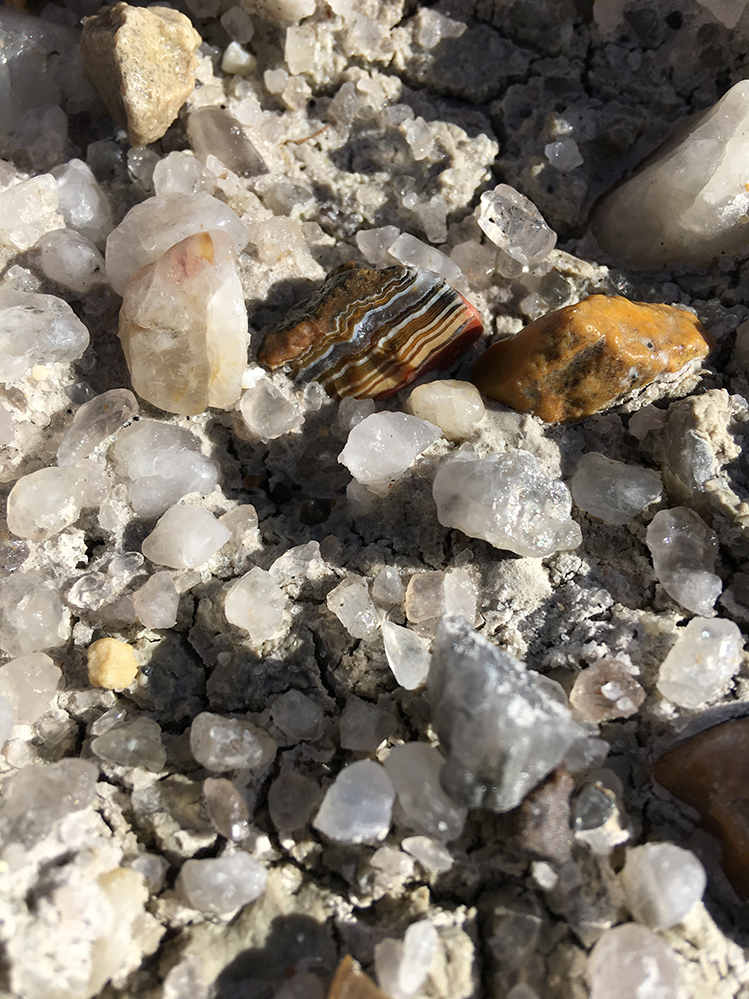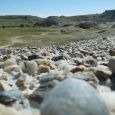The Gift of South Dakota
Subscriptions to South Dakota Magazine make great gifts!
Subscribe today — 1 year (6 issues) is just $29!
The Luckiest Rockhound
Aug 20, 2019
 |
| Fairburn agates, found in southwestern South Dakota, are prized finds among rock hounds. |
When I was a kid, I spent hours looking through a box of rocks. They weren’t ordinary stones like you might find in your driveway or on the gravel road out to Grandma’s. This box included specimens that were downright exotic to a young South Dakotan: pyrite, obsidian, quartz, talc and schist. It’s where I first learned that rocks weren’t just rocks. There were sedimentary and igneous and metamorphic rocks. There were minerals and gemstones, and different regions of the world were famous for producing specific kinds.
South Dakota is known in the rock hounding world for Fairburn agates, which are among the most elusive stones on earth. They are found in only a few spots in southwestern South Dakota, chiefly in agate beds near Fairburn in Custer County (hence the name). Geologists are still unsure how they form. During the age in which they were created, 250 million to 350 million years ago, western South Dakota lay beneath a vast ocean. Some geologists believe that water rich in silica slowly trickled through passageways in the rock. Over time, that silica accumulated inside tiny pockets, creating an agate. Other compounds in the water, such as iron oxide (red) and manganese oxide (black) created the Fairburn’s tight banding and brilliant colors, characteristics that are unlike any other gemstone in the world.
During the Black Hills uplift, between 35 million and 70 million years ago, around 400 square miles of the agate-rich Minnilusa Formation — the limestone ring that encircles the Black Hills — was eroded and swept east into the Badlands. Today, hunters from around the world descend upon these agate beds hoping to find a rare Fairburn, or even a piece of a Fairburn.
I decided to try my luck. I met Don Bahr, a veteran West River rockhound, in Rapid City and we headed south down Highway 79 toward Fairburn. The agate beds are about 14 miles east of town. Clouds of dust billowed behind Bahr’s Jeep as we sped down the gravel. Fording French Creek proved no problem; it was a dry summer, and nary a trickle flowed through the stream bed at the rough entrance to the agate beds.
We stepped out onto a moonscape. It was barely 9 a.m., but already the gumbo hills had been baked by the hot morning sun. The hills were strewn with stones: white and rose quartz, tiny pieces of petrified wood and a multitude of others.
Our hunting tools were simple: a three-tined garden rake and a spray bottle of water. Bahr ran the rake over the top layer of stones, hoping to turn over a Fairburn or reveal one that might barely be exposed. A spritz of water would accentuate the colors and signature tight banding.
In the months leading up to our trip, Bahr had reminded me that people spend days scouring the hills for Fairburns and leave empty handed. They might find a similar agate — a water agate, prairie agate, or bubblegum agate, to name a few of the many varieties — but Fairburns are the prize. He was explaining the difference between the many agates when he stopped mid-sentence. “There’s Fairburn right there!” he said, barely able to contain his disbelief.
Within our first 20 minutes, we had discovered a fragment of a Fairburn agate. It’s outer matrix was chocolatey-brown, but inside we saw tight bands and blue, brown, red and yellow layers. “There could be more right around here,” he said, so we scraped and kicked at the surface rocks. We searched for another 90 minutes, but came away with nothing more.
I attribute the find to beginner’s luck with a little help from Mother Nature. The night before our search, about an inch of rain had fallen on the agate beds. Bahr believed that helped expose new stones that had lain just beneath the surface.
Later that evening at a Rapid City restaurant, I called my wife to tell her about the agate hunting trip. When I got off the phone, a waiter stopped at my table. “Did you say you found a Fairburn?” he asked.
He stared in awe when I showed him the photo on my phone. Yes, South Dakota’s Fairburn agates are a prize to behold, and the search for them does get in your blood.










Comments